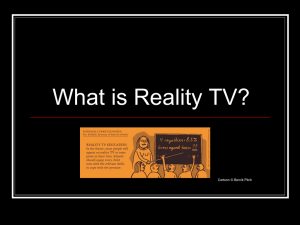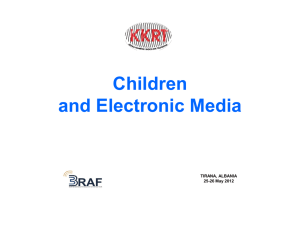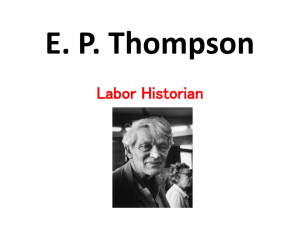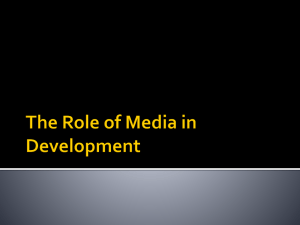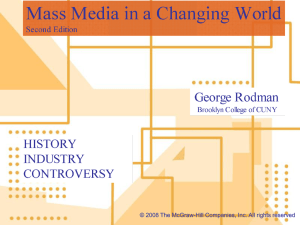Characteristics of Quality Television (1996)
advertisement
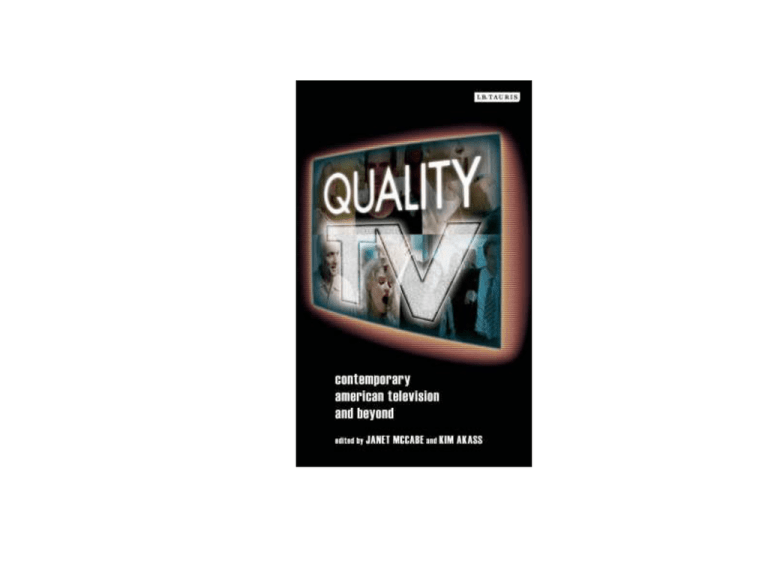
LOP: Least Objectionable Programming Pre-1970s American network designation for a television program capable of retaining a viewer’s apathetic attention; televsion not likely to provoke a pre-RCD viewers to rise from the sofa to change the channel. Characteristics of Quality Television (1996) “Preface”--“The Golden Age of Television" to "Quality TV” (Robert J. Thompson, Television’s Second Golden Age: From Hill Street Blues to ER. New York: Continuum, 1996) Robert J. Thompson’s Characteristics of Quality Television (1996) 1. Quality TV is best defined by what it is not. It is not "regular" TV. The worst insult you could give to Barney Rosenzweig, the executive producer of Cagney & Lacey, was to tell him that his work was "too TV.” Twin Peaks was universally praised by critics for being "unlike anything we'd ever seen on television." In a medium long considered artless, the only artful TV is that which isn't like all the rest of it. Quality TV breaks rules. It may do this by taking a traditional genre and transforming it, as Hill Street Blues, St. Elsewhere, and Moonlighting did to the cop show, the doctor show, and the detective show, respectively. Or it may defy standard generic parameters and define new narrative territory heretofore unexplored by television, as did thirtysomething and Twin Peaks. Robert J. Thompson’s Characteristics of Quality Television (1996) 2. Quality TV usually has a quality pedigree. Shows made by artists whose reputations were made in other, classier media, like film, are prime candidates. Furthermore, directors of small art films have a better chance of making quality TV than directors of blockbuster movies. John Sayles's Shannon's Deal and David Lynch's Twin Peaks both got the quality nod by most critics; Steven Spielberg's SeaQuest DSV did not. As the genre developed through the 1980s, a few creators who'd worked exclusively in TV also became associated with this designer label television. Since Hill Street Blues, for example, any show with Steven Bochco's name on it is presumed quality (NYPD Blue) until proven otherwise (Capitol Critters). In all of these cases, the creators usually insist upon and get a much greater degree of independence from network influence than is typical in the production process of commercial TV. Robert J. Thompson’s Characteristics of Quality Television (1996) 3. Quality TV attracts an audience with blue chip demographics. The upscale, well-educated, urbandwelling, young viewers advertisers so desire to reach tend to make up a much larger percentage of the audience of these shows than of other kinds of programs. Robert J. Thompson’s Characteristics of Quality Television (1996) 4. Desirable demographics notwithstanding, quality shows must often undergo a noble struggle against profit-mongering networks and non-appreciative audiences. The hottest battles between Art and Commerce, between creative writer-producers and bottom-lineconscious executives are often played out during the runs of these series. With some obvious exceptions, these shows seldom become blockbusters and their survival is often tenuous, at least at the beginning. Their futures often hang in the balance between network noblesse oblige (the renewing and promoting of a low-rated show) and network stupidity (scheduling it in a deadly time slot). When a quality show does become a hit, it is often after a long struggle and some unusual circumstances. Hill Street Blues reached the top twenty-five only after it won a record-breaking batch of Emmy Awards; Cagney & Lacey was canceled three times on the way to ratings respectability; NYPD Blue debuted strongly after its forbidden language and nudity were reported in nearly every paper in America and a handful of stations refused to air the show. Robert J. Thompson’s Characteristics of Quality Television (1996) 5. Quality TV tends to have a large ensemble cast. The variety of characters allows for a variety of vlewpoints. Since multiple plots must usually be employed to accommodate all of the characters. Robert J. Thompson’s Characteristics of Quality Television (1996) 6. Quality TV has a memory. Though it may or may not be serialized in continuing story lines, these shows tend to refer back to previous episodes. Characters develop and change as the series goes on. Events and details from previous episodes are often used or referred to in subsequent episodes. Robert J. Thompson’s Characteristics of Quality Television (1996) 7. Quality TV creates a new genre by mixing old ones. When describing Northern Exposure's creolized generic heritage, for example, Betsy Williams says that while the show "is usually billed as a drama ... it functions more as an hour-long ensemble comedy with a slight nod to the medical franchise, another to primetime melodrama, another to the fish-out-of-water sitcom, and still another to the sixties' “magicom.” All quality shows integrate comedy and tragedy in a way Aristotle would never have approved. Robert J. Thompson’s Characteristics of Quality Television (1996) 8. Quality TV tends to be literary and writer-based. The writing is usually more complex than in other types of programming. Robert J. Thompson’s Characteristics of Quality Television (1996) 9. Quality TV is self-conscious. Oblique allusions are made to both high and popular culture, but mostly to TV itself: Moonlighting, for example, could bury an obscure reference to a play by Eugene O'Neill right alongside a direct address to the camera about the fact that Moonlighting had been airing a lot of reruns lately. Both the classier cultural references and the sly, knowing jabs at TV serve to distance these programs from the stigmatized medium and to announce that they are far superior to the typical trash available on television. Robert J. Thompson’s Characteristics of Quality Television (1996) 10. The subject matter of quality TV tends toward the controversial. St. Elsewhere presented the first prime-time series story about AIDS, and other quality series frequently included some of television's earliest treatments of subjects like abortion, homosexuals, racism, and religion, to name a few. The overall message almost always tends toward liberal humanism. So consistent have these shows been in this regard that it is hard to imagine a right-wing "quality TV" series. "Quality TV is liberal TV," Jane Feuer making no bones about it, wrote in MTM: Quality Television. Robert J. Thompson’s Characteristics of Quality Television (1996) 11. Quality TV aspires toward "realism." Robert J. Thompson’s Characteristics of Quality Television (1996) 12. Series which exhibit the eleven characteristics listed above are usually enthusiastically showered with awards and critical acclaim. Since the 1980-1981 season, shows of the type described in this list have dominated the best drama category for most major entertainment awards. Emmy Awards for best drama went to Hill Street Blues and L.A. Law four times each, Cagney & Lacey and Picket Fences twice, and thirtysomething and Northern Exposure once each. Best Drama Golden Globes for the same period went to Hill Street twice, L.A. Law twice, Northern Exposure twice, and thirtysomething, China Beach, and Twin Peaks once each. Peabody Awards went to Hill Street Blues, St. Elsewhere, L.A. Law, thirtysomething, China Beach, Twin Peaks, and Northern Exposure. The award for best dramatic episode was given Robert J. Thompson’s Characteristics of Quality Television (1996) 12. by the Writers' Guild of America three times to Hill Street Blues and Moonlighting, twice to Cagney & Lacey and China Beach, and once each to Miami Vice, St. Elsewhere, and thirtysomething. A survey of college professors and TV critics con-[16] ducted by the Siena Research Institute in 1990 named Hill Street Blues the best television drama ever, and when the editors of TV Guide compiled an "All Time Best TV" list in 1993, the all-time best drama went to St. Elsewhere and the all-time best cop show to Hill Street Blues." When this author asked TV critics from the 388 largest circulation daily newspapers to name the best prime-time TV shows of all time, Hill Street Blues came out on top. Characteristics of Quality Television Revisited (2007) Robert J. Thompson, “Preface” to Quality TV (edited by Janet McCabe and Kim Akass [London: Tauris, 2007]). Characteristics of Quality Television Revisited (2007) Quality shows are no longer “specialized offerings of the network” Characteristics of Quality Television Revisited (2007) The “quality TV aesthetic” has spread “like a virus” Characteristics of Quality Television Revisited (2007) Quality TV is now part of a “massive repackaging strategy across generic lines,” a “retooling comparable to the switchover to colour three decades earlier.” Characteristics of Quality Television Revisited (2007) Quality TV is now “a supergenre, a formula unto itself” Characteristics of Quality Television Revisited (2007) Although cable television is now seen as the “test kitchen” for Quality TV, it followed the lead of more experimental network television in the 1990s. Characteristics of Quality Television Revisited (2007) “The precise definition of ‘quality TV’ was elusive right from the start, though we knew it when we saw it. These shows were generic mongrels, often scrambling and recombining traditional TV formulas in unexpected ways; they had literary and cinematic ambitions beyond what we had seen before, and they employed complex and sophisticated serialized narratives and inter-series ‘mythologies.’ Back in the 1980s we breathlessly celebrated these new aesthetic approaches and challenges being taken on by a medium that had changed very little since the 1950s. But by the century’s end, these innovations had become formulas.”


